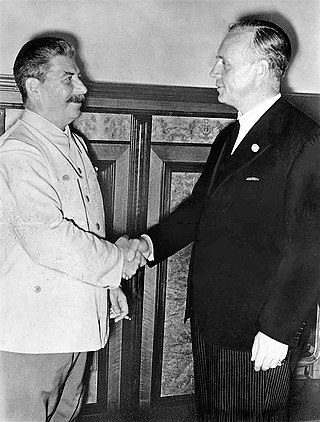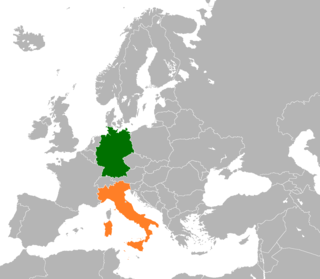
The Molotov–Ribbentrop Pact, officially the Treaty of Non-Aggression between Germany and the Union of Soviet Socialist Republics, was a non-aggression pact between Nazi Germany and the Soviet Union with a secret protocol that partitioned Central and Eastern Europe between them. The pact was signed in Moscow on 23 August 1939 by German Foreign Minister Joachim von Ribbentrop and Soviet Foreign Minister Vyacheslav Molotov. Unofficially, it has also been referred to as the Hitler–Stalin Pact and the Nazi–Soviet Pact.

The Axis powers, originally called the Rome–Berlin Axis and also Rome–Berlin–Tokyo Axis, was a military coalition that initiated World War II and fought against the Allies. Its principal members were Nazi Germany, the Kingdom of Italy and the Empire of Japan. The Axis were united in their far-right positions and general opposition to the Allies, but otherwise lacked comparable coordination and ideological cohesion.

The Pact of Steel, formally known as the Pact of Friendship and Alliance between Germany and Italy was a military and political alliance between Italy and Germany.

The Anti-Comintern Pact, officially the Agreement against the Communist International was an anti-Communist pact concluded between Nazi Germany and the Empire of Japan on 25 November 1936 and was directed against the Communist International (Comintern). It was signed by German ambassador-at-large Joachim von Ribbentrop and Japanese ambassador to Germany Kintomo Mushanokōji. Italy joined in 1937, but it was legally recognized as an original signatory by the terms of its entry. Spain and Hungary joined in 1939. Other countries joined during World War II.

The Abyssinia Crisis, also known in Italy as the Walwal incident, was an international crisis in 1935 that originated in a dispute over the town of Walwal, which then turned into a conflict between the Fascist-ruled Kingdom of Italy and the Ethiopian Empire. The League of Nations ruled against Italy and voted for economic sanctions, but they were never fully applied. Italy ignored the sanctions, quit the League, made special deals with the United Kingdom and France and ultimately annexed and occupied Abyssinia after it had won the Second Italo-Ethiopian War. The crisis is generally regarded as having discredited the League.

Maxim Maximovich Litvinov was a Russian revolutionary and prominent Soviet statesman and diplomat who served as People's Commissar for Foreign Affairs from 1930 to 1939.

The causes of World War II have been given considerable attention by historians. The immediate precipitating event was the invasion of Poland by Nazi Germany on September 1, 1939, and the subsequent declarations of war on Germany made by Britain and France, but many other prior events have been suggested as ultimate causes. Primary themes in historical analysis of the war's origins include the political takeover of Germany in 1933 by Adolf Hitler and the Nazi Party; Japanese militarism against China, which led to the Japanese invasion of Manchuria and the Second Sino-Japanese War; Nationalist uprising in Spain, which led to the Spanish Civil War; or Italian aggression against Ethiopia, which led to the Second Italo-Ethiopian War.

German–Soviet Union relations date to the aftermath of the First World War. The Treaty of Brest-Litovsk, dictated by Germany ended hostilities between Russia and Germany; it was signed on March 3, 1918. A few months later, the German ambassador to Moscow, Wilhelm von Mirbach, was shot dead by Russian Left Socialist-Revolutionaries in an attempt to incite a new war between Russia and Germany. The entire Soviet embassy under Adolph Joffe was deported from Germany on November 6, 1918, for their active support of the German Revolution. Karl Radek also illegally supported communist subversive activities in Weimar Germany in 1919.

In the history of the 20th century, the interwar period lasted from 11 November 1918 to 1 September 1939 – from the end of World War I to the beginning of World War II. It was relatively short, yet featured many social, political, and economic changes throughout the world. Petroleum-based energy production and associated mechanisation led to the prosperous Roaring Twenties, a time of social and economic mobility for the middle class. Automobiles, electric lighting, radio, and more became common among populations in the first world. The era's indulgences were followed by the Great Depression, an unprecedented worldwide economic downturn that severely damaged many of the world's largest economies.

After the Russian Revolution, in which the Bolsheviks took over parts of the collapsing Russian Empire in 1918, they faced enormous odds against the German Empire and eventually negotiated terms to pull out of World War I. They then went to war against the White movement, pro-independence movements, rebellious peasants, former supporters, anarchists and foreign interventionists in the bitter civil war. They set up the Soviet Union in 1922 with Vladimir Lenin in charge. At first, it was treated as an unrecognized pariah state because of its repudiating of tsarist debts and threats to destroy capitalism at home and around the world. By 1922, Moscow had repudiated the goal of world revolution, and sought diplomatic recognition and friendly trade relations with the capitalist world, starting with Britain and Germany. Finally, in 1933, the United States gave recognition. Trade and technical help from Germany and the United States arrived in the late 1920s. After Lenin died in 1924, Joseph Stalin, became leader. He transformed the country in the 1930s into an industrial and military power. It strongly opposed Nazi Germany until August 1939, when it suddenly came to friendly terms with Berlin in the Molotov–Ribbentrop Pact. Moscow and Berlin by agreement invaded and partitioned Poland and the Baltic States. Stalin ignored repeated warnings that Hitler planned to invade. He was caught by surprise in June 1941 when Nazi Germany invaded the Soviet Union. The Soviet forces nearly collapsed as the Germans reached the outskirts of Leningrad and Moscow. However, the Soviet Union proved strong enough to defeat Nazi Germany, with help from its key World War II allies, Britain and the United States. The Soviet army occupied most of Eastern Europe and increasingly controlled the governments.

This timeline of events preceding World War II covers the events that affected or led to World War II.

Relations between the Soviet Unionand Japan between the Communist takeover in 1917 and the collapse of Communism in 1991 tended to be hostile. Japan had sent troops to counter the Bolshevik presence in Russia's Far East during the Russian Civil War, and both countries had been in opposite camps during World War II and the Cold War. In addition, territorial conflicts over the Kuril Islands and South Sakhalin were a constant source of tension. These, with a number of smaller conflicts, prevented both countries from signing a peace treaty after World War II, and even today matters remain unresolved.

The remilitarisation of the Rhineland began on 7 March 1936, when military forces of the German Reich entered the Rhineland, which directly contravened the Treaty of Versailles and the Locarno Treaties. Neither France nor Britain was prepared for a military response, so they did not act. After 1939, commentators often said that a strong military move in 1936 might have ruined the expansionist plans of Adolf Hitler, the dictator of Germany. However, recent historiography agrees that both public and elite opinion in Britain and France strongly opposed a military intervention, and neither had an army prepared to move in.
The Franco-Soviet Treaty of Mutual Assistance was a bilateral treaty between France and the Soviet Union with the aim of enveloping Nazi Germany in 1935 to reduce the threat from Central Europe. It was pursued by Maxim Litvinov, the Soviet foreign minister, and Louis Barthou, the French foreign minister, who was assassinated in October 1934, before negotiations had been finished.

Italy–Russia relations are the bilateral foreign relations between the two countries, embodied in the so-called privileged relationship. Both countries are full members of the Organization for Security and Co-operation in Europe.

Germany–Italy relations are the international relations between the Federal Republic of Germany and the Italian Republic. Both countries are full members of the European Union and NATO.

Russia–Taiwan relations or Taiwan–Russia relations are the bilateral foreign relations between Taiwan and Russia. Due to the 2022 Russian invasion of Ukraine, relations became tense after Taiwan imposed sanctions against Russia. Russia placed Taiwan on a list of "unfriendly countries", along with South Korea, Japan, Singapore, the United States, European Union members, NATO members, Canada, Australia, New Zealand, Norway, Switzerland, Micronesia and Ukraine.

The Molotov–Ribbentrop Pact was an August 23, 1939, agreement between the Soviet Union and Nazi Germany colloquially named after Soviet foreign minister Vyacheslav Molotov and German foreign minister Joachim von Ribbentrop. The treaty renounced warfare between the two countries. In addition to stipulations of non-aggression, the treaty included a secret protocol dividing several eastern European countries between the parties.
International relations (1919–1939) covers the main interactions shaping world history in this era, known as the interwar period, with emphasis on diplomacy and economic relations. The coverage here follows the diplomatic history of World War I and precedes the diplomatic history of World War II. The important stages of interwar diplomacy and international relations included resolutions of wartime issues, such as reparations owed by Germany and boundaries; American involvement in European finances and disarmament projects; the expectations and failures of the League of Nations; the relationships of the new countries to the old; the distrustful relations between the Soviet Union and the capitalist world; peace and disarmament efforts; responses to the Great Depression starting in 1929; the collapse of world trade; the collapse of democratic regimes one by one; the growth of economic autarky; Japanese aggressiveness toward China; fascist diplomacy, including the aggressive moves by Fascist Italy and Nazi Germany; the Spanish Civil War; the appeasement of Germany's expansionist moves toward the Rhineland, Austria, and Czechoslovakia, and the last, desperate stages of rearmament as another world war increasingly loomed.

Fascist Italy is a term used to describe the Kingdom of Italy governed by the National Fascist Party from 1922 to 1943 with Benito Mussolini as prime minister and dictator. The Italian Fascists imposed totalitarian rule and crushed political opposition, while promoting economic modernization, traditional social values and a rapprochement with the Roman Catholic Church.

















